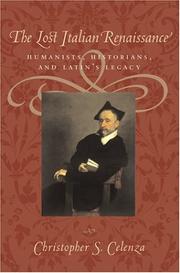[The
above video is mostly a reading of the text below, with an occasional aside
thrown in for good measure as they strike me as relevant. I
welcome questions, comments, or concerns about the material contained in this
video.]
For some reason, I have lately been the lucky recipient of numerous academic catalogues, especially from university presses that are having sales with as much as 75% off. One of the more recent ones, from Johns Hopkins, had this in it, and for a mere five dollars. It might have been better-suited for someone more thoroughly steeped in the formal study of the Italian Renaissance than I can admit to being, but what it had to say about the current state of study in this area was interesting. It certainly couches many of the problems of contemporary Italian Renaissance studies in interesting ways, and makes the reader privy to a lot of “insider” information. In this book, Celenza is mostly concerned with the formation and current state of Renaissance studies, and particularly the effects that certain sources (or lack thereof) have wrought upon that study.
“The Lost Italian Renaissance” is more a series of interconnected essays on a group of related themes than it is a book with a continuous argument. The first essay argues that twentieth-century Italian Renaissance studies seriously suffers from a lack of sources that were originally written in Latin for a number of reasons, but mostly because scholars from the previous (that is, the nineteenth) century thought that non-vernacular languages were of at most secondary importance (mostly because of the rise of nationalist conceptions of history, like that of Herder). Because of this, many of the most important sources in Latin have still not been sourced, recorded, and critically edited for the sake of posterity. The second chapter discusses two contemporary scholars in the field, Eugenio Garin and Paul Oskar Kristeller, their approaches to comparative historiography, and how they each contributed to a rediscovery of these important Latin manuscripts.
The rest of the book tries to construct an approach to the Italian Renaissance by looking at philosophical approaches to history including the synchronic and diachronic and looking at the way individual thinkers, including Claude Levi-Strauss and Richard Rorty, have thought about these problems. The last chapters try to build case studies in model intellectual history upon the ideas he has offered. He uses one essay to compare Lorenzo Valla to Marcilio Ficino, and the next to look at how traditional ideas of honor in the Italian Renaissance were tied to notions of masculinity and gender construction.
I would recommend this to anyone with a formal, academic interest in this area. I felt that I definitely would have learned more had I been more familiar with some of the problematic aspects of what Celenza was talking about, including the contributions of Eugenio Garin and Paul Oskar Kristeller.
“The Lost Italian Renaissance” is more a series of interconnected essays on a group of related themes than it is a book with a continuous argument. The first essay argues that twentieth-century Italian Renaissance studies seriously suffers from a lack of sources that were originally written in Latin for a number of reasons, but mostly because scholars from the previous (that is, the nineteenth) century thought that non-vernacular languages were of at most secondary importance (mostly because of the rise of nationalist conceptions of history, like that of Herder). Because of this, many of the most important sources in Latin have still not been sourced, recorded, and critically edited for the sake of posterity. The second chapter discusses two contemporary scholars in the field, Eugenio Garin and Paul Oskar Kristeller, their approaches to comparative historiography, and how they each contributed to a rediscovery of these important Latin manuscripts.
The rest of the book tries to construct an approach to the Italian Renaissance by looking at philosophical approaches to history including the synchronic and diachronic and looking at the way individual thinkers, including Claude Levi-Strauss and Richard Rorty, have thought about these problems. The last chapters try to build case studies in model intellectual history upon the ideas he has offered. He uses one essay to compare Lorenzo Valla to Marcilio Ficino, and the next to look at how traditional ideas of honor in the Italian Renaissance were tied to notions of masculinity and gender construction.
I would recommend this to anyone with a formal, academic interest in this area. I felt that I definitely would have learned more had I been more familiar with some of the problematic aspects of what Celenza was talking about, including the contributions of Eugenio Garin and Paul Oskar Kristeller.

No comments:
Post a Comment